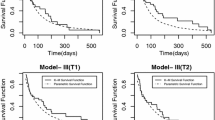Abstract
In shared frailty models for bivariate survival data the frailty is identifiable through the cross-ratio function (CRF), which provides a convenient measure of association for correlated survival variables. The CRF may be used to compare patterns of dependence across models and data sets. We explore the shape of the CRF for the families of one-sided truncated normal and folded normal frailty distributions.




Similar content being viewed by others
References
Aalen OO, Borgan Ø, Gjessing HK (2008) Survival and event history analysis: a process point of view. Springer, New York
Anderson JE, Louis TA, Holm NV, Harvald B (1992) Time-dependent association measures for bivariate survival distributions. J Am Stat Assoc 87:641–650
Azzalini A, Capitanio A (2014) The skew-normal and related families. Cambridge University Press, Cambridge
Azzalini A, Kotz S (2003) Log-skew-normal and log-skew-\(t\) distributions as models for family income data. J Income Distrib 11:12–20
Callegaro A, Iacobelli S (2012) The cox shared frailty model with log-skew normal frailties. Stat Model 12:399–418
Clayton DG (1978) A model for association in bivariate life tables and its application in epidemiological studies of family tendency in chronic disease incidence. Biometrika 65:141–151
Clayton DG, Cuzick J (1985) Multivariate generalizations of the proportional hazards model. J R Stat Soci Ser A 148:82–117
Duchateau L, Janssen P (2008) The frailty model. Springer, New York
Farrington CP, Unkel S, Anaya-Izquierdo K (2012) The relative frailty variance and shared frailty models. J R Stat Soc Ser B 74:673–696
Hougaard P (2000) Analysis of multivariate survival data. Springer, New York
Hougaard P (2014) Frailty models. In: Klein JP, van Houwelingen HC, Ibrahim JG, Scheike TH (eds) Handbook of survival analysis. Chapman and Hall, London, pp 457–474
Oakes D (1989) Bivariate survival models induced by frailities. J Am Stat Assoc 84:487–493
Paik MC, Tsai W-Y, Ottman R (1994) Multivariate survival analysis using piecewise gamma frailty. Biometrics 50:975–988
R Core Team (2015) R: a language and environment for statistical computing. R Foundation for Statistical Computing, Vienna. https://www.R-project.org
Sahu S K, Dey D K (2004) On a Bayesian multivariate survival model with a skewed frailty. In: Genton M G (ed) Skew-elliptical distributions and their applications: a journey beyond normality. CRC Press, Boca Raton, pp 321–338
Viswanathan B, Manatunga AK (2001) Diagnostic plots for assessing the frailty distribution in multivariate survival data. Lifetime Data Anal 7:143–155
Wienke A (2011) Frailty models in survival analysis. CRC Press, Boca Raton
Acknowledgements
The author gratefully acknowledges David Ellenberger for proofreading the manuscript. One reviewer made valuable comments and suggestions on the first draft of this paper.
Author information
Authors and Affiliations
Corresponding author
Appendix
Appendix
1.1 One-sided truncated normal distribution
1.2 Folded normal distribution
Rights and permissions
About this article
Cite this article
Unkel, S. On the shape of the cross-ratio function in bivariate survival models induced by truncated and folded normal frailty distributions. Metrika 80, 351–362 (2017). https://doi.org/10.1007/s00184-016-0608-6
Received:
Published:
Issue Date:
DOI: https://doi.org/10.1007/s00184-016-0608-6




